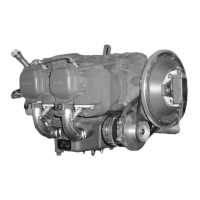SECTION 3 LYCOMING OPERATOR’S MANUAL
OPERATING INSTRUCTIONS O-320 SERIES
(2) Take-Off – Take-offs and full throttle operation should be made with carburetor heat in full cold
position. The possibility of throttle icing at wide throttle openings is very remote, so remote in
fact, that it can be disregarded.
(3) Climbing – When climbing at part throttle power settings of 80% or above, the carburetor heat
control should be set in the full cold position; however, if it is necessary to use carburetor heat to
prevent icing it is possible for engine roughness to occur due to the over-rich fuel-air mixture
produced by the additional carburetor heat. When this happens, carefully lean the mixture with the
mixture control only enough to produce smooth engine operation. Do not continue to use
carburetor heat after flight is out of icing conditions, and adjust mixture according to percent of
power and altitude.
(4) Flight Operation – During normal flight, leave the carburetor air heat control in the cold position.
On damp, cloudy, foggy or hazy days, regardless of the outside air temperatures, look out for loss
of power. This will be evidenced by an unaccountable loss in manifold pressure or RPM or both,
depending on whether a constant speed or fixed pitch propeller is installed on the aircraft. If this
happens, apply full carburetor air heat and increase the throttle, if available to compensate for
power loss. This will result in a slight additional drop in manifold pressure which is normal, and
this drop will be regained as the ice is melted out of the induction system. When ice has been
melted from the induction system, heat should be used as long as known or suspected icing exists.
Only in those aircraft equipped with a carburetor air temperature gage may partial heat be used to
keep the mixture temperature above freezing point (32°F). Be alert to the threat of carburetor icing
during reduced power operation on or above water.
WARNING
IT IS ADVISABLE TO USE EITHER FULL HEAT OR NO HEAT IN AIRCRAFT THAT ARE
NOT EQUIPPED WITH A CARBURETOR AIR TEMPERATURE GAGE. AT AN AMBIENT
TEMPERATURE OF 14°F OR BELOW, ANY MIXTURE IN THE AIR IS FROZEN AND
HEAT SHOULD NOT BE USED.
(5) Landing Approach – In making a landing approach, the carburetor heat should usually be in the
“Full Cold” position. However, if icing conditions are known or suspected, the “Full Heat” should
be applied. In the case that full power need be applied under these conditions, as for an aborted
landing, the carburetor heat should be returned to “Full Cold” prior to full power application. See
the aircraft flight manual for specific instructions. As a safety measure, there is no objection to the
use of carburetor heat during landing approach provided that on a go-around, or touch-and-go
landing, the carburetor heat is returned promptly to the cold position.
9. ENGINE FLIGHT CHART.
FUEL AND OIL
Model Aviation Grade Fuel
O-320-A, -E Series........................................................................................................ 80/87 octane, minimum
O-320-B, -D (except –B2D, -B2E, -D2J) ................................................... 91/96 or 100/130 octane, minimum
O-320-B2D, -B2E .................................................................................. 91/96 or 100/100LL octane, minimum
O-320-D2J.............................................................................................................100/100LL octane, minimum
NOTE: Aviation grade 100/100LL fuels in which the lead content is limited to 2 c.c. per gal. are approved
for continuous use in the above listed engines.
3-6

